Imagine jars of delicious home-canned goulash, just sitting on your pantry shelves ready for wonderfully-warming weeknight suppers.
Your family may have its own traditional variation of goulash; you can customize this as you wish upon opening a jar.
You can use beef, or pork.
You may wish to double or triple this recipe to get a full canner load: if so, just do your calculations on paper first before proceeding so that you aren’t trying to do mental gymnastics in the thick of things.
The recipe
Jar size choices: Half-litre (US pint / 16 oz) OR litre (US quart / 32 oz)
Processing method: Pressure canning only
Yield: 4 x half-litre (pint) OR 2 x litre (quart) jars
Headspace: 3 cm (1 inch)
Processing pressure: 10 lbs (69 kPa) weighted gauge, 11 lbs (76 kpa) dial gauge (adjust pressure for your altitude when over 300 metres / 1000 feet.)
Processing time: Half-litres (pints) 75 minutes; litres (quarts) 90 minutes
If you don’t have a pressure canner, you can freeze this in plastic containers or straight-sided jars with no shoulders. (Water-bath canning is not acceptable for safety reasons.)
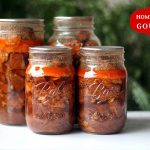
Goulash
Ingredients
- 2 kg stewing beef (or stewing pork. 4 lbs)
- 20 peppercorns
- 3 bay leaves
- 2 teaspoons caraway seeds (optional)
- 6 celery (stalks)
- 4 carrots ((large, cut in half)
- 3 onions medium
- 3 tablespoons paprika
- 1 tablespoon salt (OR non-bitter, non-clouding salt sub)
- 2 teaspoons mustard powder
- 75 ml vegetable oil (⅓ cup / 3 oz)
- 400 ml water (1 ½ cups / 12 oz)
- 75 ml vinegar (⅓ cup / 3 oz)
Instructions
- Cut meat into 3 cm (1 inch) cubes. Set aside in a large bowl.
- Make a spice bag holding the peppercorns, bay leaves, and caraway seeds. Set aside.
- Wash the celery stalks, cut in half lengthwise, put in a large pot.
- Wash the carrots, peel, then wash again. Cut in half lengthwise, add to the large pot.
- Wash the onions, peel, then cut in half, keeping a bit of the root section in each half so the onion will stay together better. Add to pot.
- Make a spice mix from the paprika, salt or salt sub, and dry mustard.
- Pour a bit of the spice mix over the cubes, toss, add a bit more spice mix, toss again and continue until spice mix is all added and meat cubes are all coated with the spice mix.
- In a large frying pan heat some of the oil. Add some meat cubes, brown. Put the browned ones in the large pot with the vegetables.
- Continue until all meat cubes are browned, adding some oil to the frying pan as needed.
- Use the water to deglaze the frying pan, and pour that into the pot with the browned meat cubes and vegetables.
- Add spice bag to pot.
- Add vinegar to pot.
- EITHER pressure cook mixture for 7 to 10 minutes (see notes) OR bring to a boil, then lower to a simmer, and let simmer covered until meat is just tender. About 1 hour depending on the meat you are using.
- Remove spice bag and vegetables and discard (or reserve vegetables for another use.)
- Jar size choices: half-litre (1 US pint) or 1 litre (US quart)
- Distribute meat and sauce between heated jars. If you have extra sauce, you could can it in a separate jar or freeze it. If you don't have enough, you can top up jars with boiling water from a kettle.
- Leave 3 cm (1 inch) headspace.
- Debubble; adjust headspace.
- Wipe jar rims.
- Put lids on.
- Processing pressure: 10 lbs (69 kPa) weighted gauge, 11 lbs (76 kpa) dial gauge (adjust pressure for your altitude when over 300 metres / 1000 feet.)
- Processing time: half- litre (1 US pint) 75 minutes; 1 litre (US quart) 90 minutes.
Nutrition
See also if applicable: Dial Gauge Pressures.
Reference information
How to pressure can.
When pressure canning, you must adjust the pressure for your altitude.
For salt substitute, Herbamare Sodium-Free was used.
Recipe notes
- The beef can be a tougher cut such as round, chuck, etc. For the pork, any cut you choose.
- You are keeping the vegetables in large pieces so they will be easier to remove.
- There are some versions of Goulash that have vegetables in them, but many people see that as sacrilege. Goulash is a topic that fierce wars have been fought over. Bernardin and Ball could be playing it safe preference-wise by having us introduce vegetables as flavouring agents, but then remove them. (That’s why the ingredient list isn’t too fussed about exact measurements of veg.)
- If you double or triple the recipe, you are fine only using the single batch quantity of vegetables as that will be enough to do all the flavouring. Ditto the spice bag: no need to increase the quantity of spices in it.
- If you triple the recipe, you should be fine by only doubling the spice mixture.
- For the paprika, probably Hungarian would be the most authentic, but you can also use Spanish if you wish.
- Vinegar can be of your choosing. Strength doesn’t matter as it is here for flavour.
- Pressure cooker pre-cooking: You can save a lot of cooking fuel by using a pressure cooker to pre-cook the mixture instead of simmering it. To get the meat tender but not fully cooked, pressure cook the mixture on high (13 to 15 lbs) for 5 to 7 minutes (around 10 minutes perhaps in an electric pressure cooker). (Don’t do longer; 15 minutes would fully cook it to falling-apart texture. Remember, it will get cooked further as a by-product of the canning process later.)
Recipe source
Ball Blue Book. Muncie, Indiana: Healthmark LLC / Jarden Home Brands. Edition 37. 2014. Page 106.
Bernardin Guide to Home Preserving. Toronto, Canada: Bernardin Ltd. 2013. Page 96.
Modifications: none
Note: The Bernardin Guide calls for 1 ½ cups (400 ml) of water and says the caraway seeds are optional; the Ball Blue book calls for just 1 cup (250 ml) of water and doesn’t list the caraway seeds as optional. Bernardin suggests pork leg roast can be used instead of beef. Ball calls for 5% vinegar acidity, but that would be just editorial habit: the acidity would of course be irrelevant in this pressure canning recipe with full meat processing times.
Usage notes
Goulash is served unthickened in a bowl.
A traditional accompaniment is crusty bread.
Goulash with csipetke
Sometimes noodles called “csipetke” (pinched) noodles are added. They are referred to as noodles, though they are more like small dumplings.
Here is how you would do that.
- Empty a jar of goulash into a pot.
- Heat just to boiling then lower to a simmer.
- Add the noodles and cook for 5 minutes.
- Serve hot, with crusty bread on the side if desired.
To make the noodles:
- 1 egg
- pinch of salt or salt sub
- flour
- 1 or 2 teaspoons of water (optional)
- Crack the egg into a mixing bowl, and add a pinch of salt (or salt sub).
- Beat the egg.
- Add as much flour as is needed to knead the mixture into a stiff dough. You can add a teaspoon or two of water if it helps.
- Pinch small, dried-bean size pieces of dough off, and add to boiling soup. Lower soup to a simmer and let cook uncovered for about 5 minutes.
(To be clear, it’s not safe to add such dumplings before canning owing to the egg, and, because the flour would increase the density. Leaving that aside, they would absolutely not survive the pressure canning process anyway.)
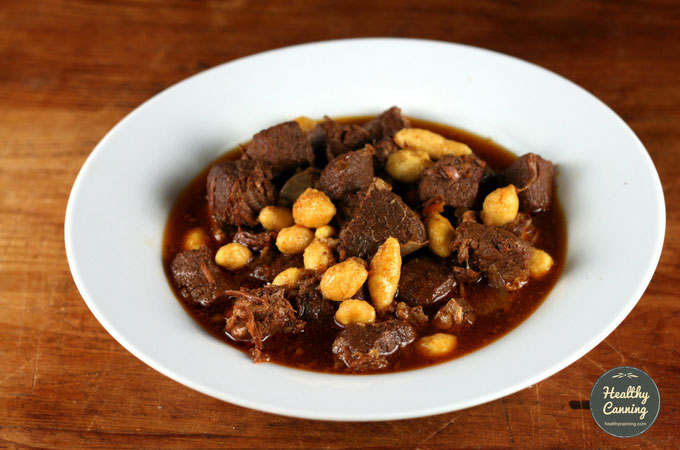
Goulash with small dumplings added upon serving.
Non-traditional serving ideas
If you wanted to, and no one Hungarian were watching, upon opening you could thicken it with cornstarch or flour, and serve over a bed of egg noodles or shredded, cooked cabbage and onion. Or just toss in macaroni instead of the small dumplings and cook until soft. But you didn’t hear that here.
Nutrition
The recipe as written is quite high in sodium (1040 mg sodium per serving — the USDA’s suggested allowance is 1500 mg for an entire day), so you may wish to scale back the salt a bit. It is just there for seasoning and can always be added to taste at the table.
Serving size: 1 cup (500 g)
Regular version
Per 1 cup (500 g): 556 calories, 1040 mg sodium
No-added salt version
Per 1 cup (500 g): 556 calories, 168 mg sodium
* Nutrition info provided by https://caloriecount.about.com

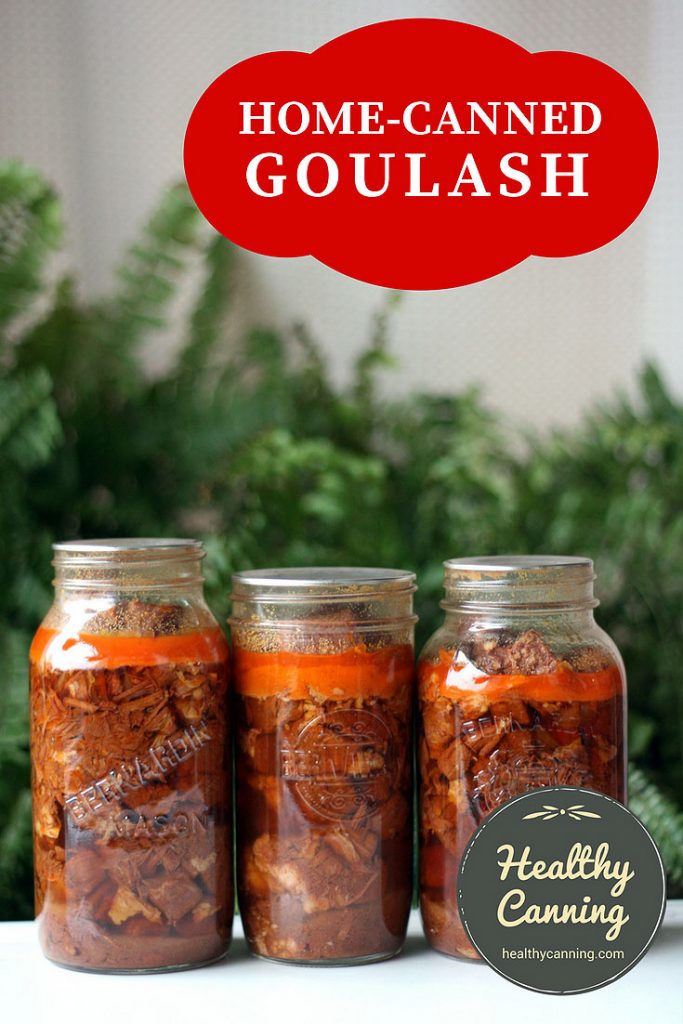
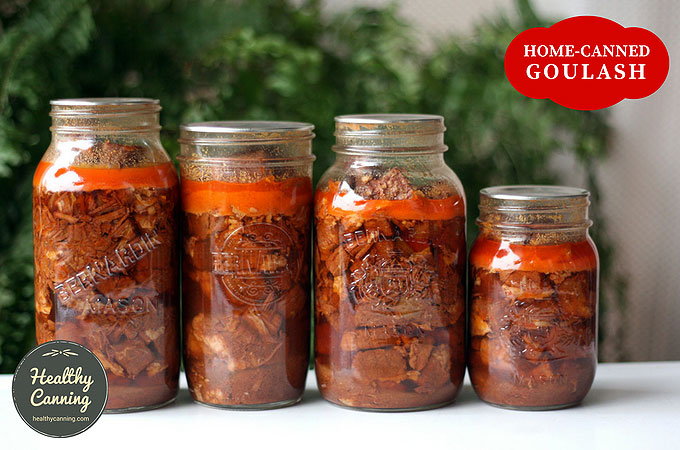
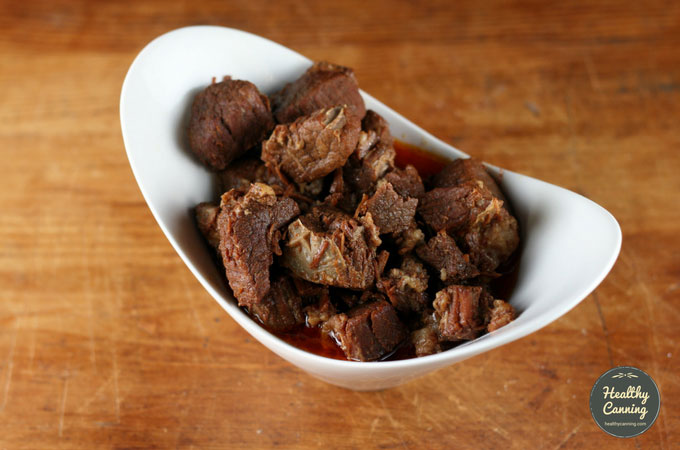
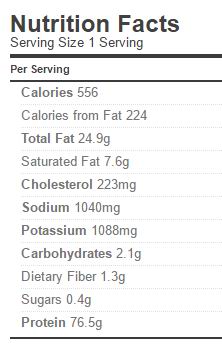
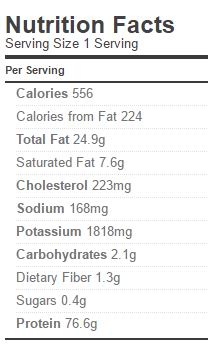

Darci Trist
It seems a waste to not keep the vegetables in! Can I can it with the vegetables in, slicing them thinner (like a stew)? And in general for these recipes that have meat, I’d prefer to have more vegetables to the quantity of meat required… is it safe to increase the amount of vegetables in the meat recipes while holding the quantity of meat the same?
Healthy Canning
Ask Ball or Bernardin directly — it’s their recipe. Quote the book and page given in the source when you ask for support on your question.